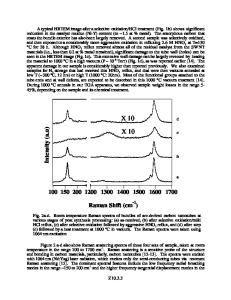Mechanism of Hydrogen Storage on Reduced Carbon Single-Walled Nanotubes
- PDF / 251,891 Bytes
- 6 Pages / 612 x 792 pts (letter) Page_size
- 25 Downloads / 435 Views
1098-HH04-04
Mechanism of Hydrogen Storage on Reduced Carbon Single-Walled Nanotubes Calvin J. Curtis1, Thomas Gennett1,2, Chaiwat Engtrakul1, Kevin O'Neill1, Jamie E. Ellis2, and Michael J. Heben1 1 Computational and Materials Science Center, National Renewable Energy Laboratory, Golden, CO, 80401 2 Department of Chemistry, Rochester Institute of Technology, Rochester, NY, 14623 ABSTRACT Carbon single-walled nanotubes (SWNTs) have been studied extensively as hydrogen storage materials. Herein, a novel hydrogen sorption behavior was observed for alkali metal reduced SWNTs and the mechanism of hydrogen binding in these materials has now been elucidated. SWNTs prepared by laser vaporization and purified by oxidation were reduced with Na in combination with naphthalene in tetrahydrofuran (THF) solution. The product, initially formulated as (Na+)xSWNTx-, was dark colored and insoluble in all common solvents examined. Temperature programmed desorption studies showed that hydrogen amounting to 3.5-4.2% w/w was released between 200 and 500ºC from the Na-reduced material. This is consistent with hydrogenation of the reduced nanotubes to form C-H bonds with a C2H empirical formula. It appears that SWNT radical anions produced by reaction with sodium deprotonate THF to form hydrogenated nanotubes and the THF cleavage products ethylene and sodium enolate, as confirmed by isotope labeling. A structure consisting of pairs of lines of C-H units that spiral about the long tube axis with a coverage of 50% of the tube carbons is proposed. INTRODUCTION Since the discovery of single-walled carbon nanotubes (SWNTs) in 1993[1] these materials have been studied extensively and shown to posses many interesting properties arising from their well-defined structure, high stability and strength, small tube diameter and high aspect ratio.[2] Our interest initially focused on hydrogen absorption on SWNTs[3] and this has lead to a broader study of SWNT chemistry and applications. Interest in reduced SWNTs was triggered by the report that sodium reduction of HipCO or arc-discharge generated SWNTs produces soluble, de-bundled materials.[4] Reduced tubes are of interest as precursors for modification of SWNTs with metals or organic functionality. However, when purified laser generated SWNTs were reduced with sodium, insoluble materials containing much less sodium but up to 4% hydrogen w/w were isolated. This paper describes labeling and spectroscopic studies aimed at elucidating the source and bonding of the hydrogen added to the SWNTs in this reduction. EXPERIMENT SWNTs were produced by laser vaporization and purified by HNO3 reflux followed by heating in air at 500C for 30 min.[5] The SWNTs used were at least 98% pure by weight. THF was distilled from Na/benzophenone and stored under purified N2. Air-sensitive materials were
stored and handled in a He-filled glove box. All reactions were carried out under inert atmosphere (Ar or N2) using Schlenk and cannula techniques. In a typical reduction reaction, ~10 mg of SWNTs were placed in a Schlenk
Data Loading...











